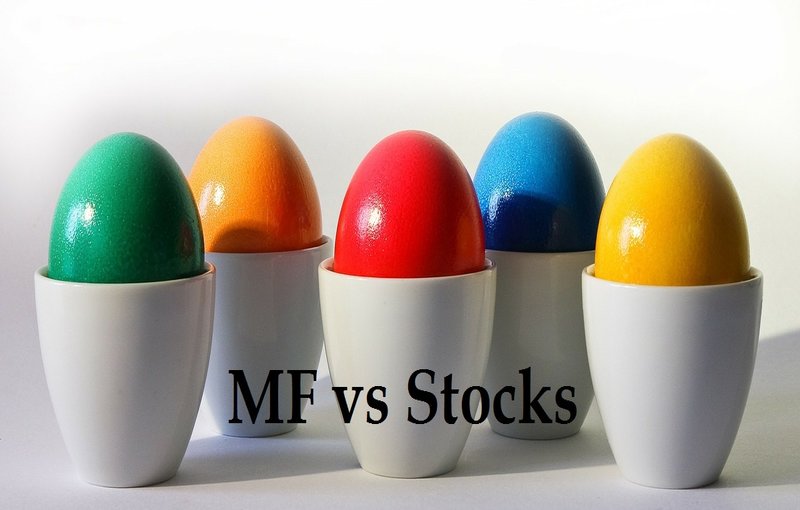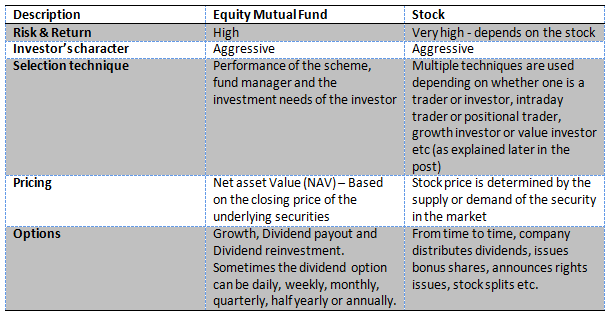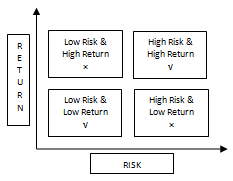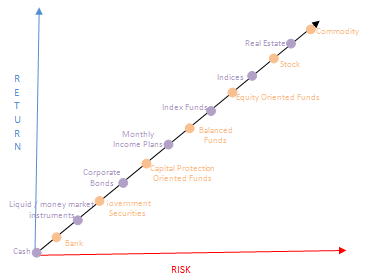Mutual Funds and Stock Investing: Do you know the 5 differences

When we think about stocks and mutual funds we think about equity. Though all stocks can be categorized as equity, all mutual funds are not equity. A mutual fund could be equity or debt or a mixture of both – usually called hybrid. Typically investors have this mindset that whether its stocks or mutual funds both are equally risky; however that’s not the case. Both investment in stocks and mutual funds are meant for different type of investors, depending upon their risk appetite, age and interest for a subject. Stated below are 5 points where stock investing is different from mutual fund.

Risk Return Trade off
Risk return trade off is basically the amount of risk taken to earn a particular return. This trade off can be better understood through the matrix drawn below. It is observed that low risk is associated with low return and vice versa; however in a marketplace it’s not possible to witness a situation where you would receive higher returns by taking lower risk. On the other hand you can take high risks and get low returns if you make bad investments.

Though there is a high level of risk in both equity mutual funds and stocks, however the degree does vary. Investing in stocks is riskier than investing in equity mutual funds. Let us understand why both stock and mutual fund being equity investment one is higher in the matrix while the other is lower.

Mutual Fund is nothing but a pool of money from numerous investors who wish to save or make money. This pool of money can be invested in securities such as stocks or bonds or money market instruments or a combination of all. In contrast to investing in a particular stock / scrip or a portfolio of stocks / scrip or indices; mutual fund investing is diversified and is usually scattered in a list of 30 to 40 securities across different sectors and is managed by a qualified experienced fund manager. Thus as seen in the matrix above, stock and index investing is higher in the chart in comparison to investing in equity mutual fund.
You may like to read demystifying mutual fund myths
Aggressive versus conservative investing
As discussed above individual stock investment lies much higher in the risk reward matrix in contrast to Equity mutual funds; thus interpreting that a stock investor shall have to take higher risk to earn higher return in distinction to an equity mutual fund investor. As a result an investor in the stock market is more aggressive in comparison to an investor in equity mutual funds.
Taking greater risk is associated with higher degree of portfolio monitoring and adjustment from time to time. In a stock market the investor will have to realign and adjust during various market conditions, such as a rally or a correction or volatility or consolidation phase in the market. A stock market investor is not only required to monitor and track news related to the company but also the industry and the economy as a whole. This high degree of monitoring is not required by a mutual fund investor as this task is executed by a professionally qualified fund manager who has the knowledge and expertise to adjust the fund’s portfolio according to the various market conditions. Therefore making investments in equity mutual funds should be your priority.
Basis of selection of Stock versus Mutual Fund
There are multiple techniques of stock selection, depending on the nature of the investor, his or her investment horizon, methodology, investment style and preferences. For example, short term investors or traders use technical analysis. They buy and sell stocks, which are giving buy or sell signals in technical charts. Even among short term traders, there are differences in techniques used by very short term traders (intraday traders, buy today sell tomorrow traders etc.) and positional traders (traders who carry their positions for a few weeks).
Long term investors use fundamental analysis (analysis of company’s financial performance, market size, company’s growth potential, valuation etc.) to select good stocks. Investment style also comes into play in stock selection. Growth investors prefer stocks which give high earnings growth, while value investors prefer stocks which are undervalued relative to its “fair price”.
There is a third set of investors who employ a blend of both growth and value styles, known a Growth at a Reasonable Price (GARP). Finally, investor preferences also come into play in stock selection. Risk appetite plays a role. Some investors prefer only blue-chip stocks, while more aggressive investors like to buy midcap stocks. Risk appetite also drives sectoral preferences.
Aggressive investors like cyclical sectors (banking, capital goods, automobile, cement etc), while others prefer defensive sectors (FMCG, Pharma, Technology etc). Cultural preferences also play a role in stock or sector selection. For example, some investors may want to stay away from certain companies like banking and finance, liquor and cigarette companies. Political preference can also play a role, if a certain companies are closer to certain political organizations.
If you want to build a portfolio of stocks, you can employ either a top-down or a bottom-up approach. Top-down approach is basically looking at the bigger picture i.e. for the investor needs to understand how the domestic economy performing visa-vise the world economy. Then the investor will have to analyze that in such an economic scenario which industries are expected to outperform the others. Within these industries investor will have to choose the stocks / company that might outperform the industry average. For example if the interest rate is falling then in a top-down approach the sectors which might outperform the others is real estate, auto and consumer durables. In the top-down approach the search for companies shall be limited to these sectors only.
On the other hand bottom-up approach overlooks the broader aspect of economy and sector and directly focuses on companies that are going to outperform the market based on individual attributes of a company. Advocates of bottom-up approach simply look out for companies with strong growth prospects and low valuations notwithstanding the current situation of the industry or economy.
Whatever be the approach the basic tenant is to select the right stock at the right time.
Mutual Fund investing is choosing the right asset type and the right fund manager. A fund manager’s mandate is to outperform the relevant market benchmark returns. A fund manager is chosen on not only the degree to which he or she has been able to outdo the benchmark returns; however he or she should be chosen on his or her consistency of performance. This consistency of performance can be measured by the number of times the funds managed by the fund manager has out beaten the market returns. A good manager creates value for the investors through, what is known as, “Alpha”. Alpha is the excess return that the fund manager generates, over and above, the returns expected by the investor for taking a certain amount of risk. Alpha is created by superior stock selection, a capability which the fund managers have and average retail investors lack.
Remember asset allocation is much more important than fund selection.
Understand your asset profile with the help of this Tool: My Asset Profiler
Determination of price:
Net asset value or the NAV of a mutual fund is calculated by taking the weighted average closing price of the securities held by the fund in the portfolio. From this value the expenses of the funds are deducted. The total expenses divided by the assets under management is called the expenses ratio. The expenses includes the management fee and operating expenses like the registrar and transfer agent fee, audit fee, custodian fee, marketing and distribution fee. As per the regulations of the Securities and Exchange Board of India (SEBI), a mutual fund can charge a maximum expense of 2.5% (equity funds), 2.25% (debt funds), 1.5% (index funds) and 0.75% (Fund of Funds).
Price of a stock is determined by the market forces i.e. the demand and supply of the scrip in the market. With limited supply as the demand increases the price of the scrip shall also increase. Demand for particular scrip could increase because of global or domestic economic factors or sector oriented news or company specific factors.
Watch the video to know more about NAV.
Investment Options
Mutual fund investment could be lumpsum or systematically (more commonly known as systematic investment plan or SIP). Each Fund has a defined minimum amount that could be invested in the lumpsum mode and SIP mode; though this amount might vary from fund to fund usually it is Rs. 5,000 for lumpsum Investment and Rs. 500 for SIP. Fractional units can be purchased in a fund. Though there is no minimum value that has to be purchased in stocks however the quantity should be a whole number without there being any fraction or decimal part.
A mutual fund investor could choose among the two basic styles of investment growth and dividend (payout or reinvestment). If the investor wishes to reap the benefits of his investment at the end of the investment horizon then he could choose the growth or dividend reinvestment option otherwise; he could choose the dividend option where he would be receiving dividend regularly along with some capital appreciation at the end of the investment horizon. Sometimes the frequency of dividend option can also be chosen in some funds.
For stocks, company’s board may announce an interim dividend or a final dividend or a bonus issue if the company is recording profits and wishes to disseminate the returns among the investors from time to time.
Although there are some distinct differentiating factors between investing in individual stocks instead of mutual funds there are some similarities between them too. Mutual funds can be classified on the basis of market cap (large cap fund, Small & Mid Cap fund, Diversified Equity or Multi Cap fund) or sectoral funds (Infrastructure, Banking & Finance, Fast moving consumer goods or FMCG, etc.) or thematic funds (India recovery, manufacturing, exports etc.)
Evert investor is unique therefore selecting the right product is important
Stocks can be classified based on the market capitalization or sector or a particular stock could be a play on a theme of say, Indian demographics or India consumption story etc.
Conclusion
Though the debate keeps going on which is a better form of investment, the choice of the instrument is dependent solely upon the risk appetite, age, experience and expertise of the investor that determines the selection of the instrument. If an investor does not have the experience and expertise of buying the right stock at the right price, mutual fund is the safer and better option. Therefore, making investments in equity mutual funds should be a priority.
Disclaimer:
Any information contained in this article is only for informational purpose and does not constitute advice or offer to sell/purchase units of the schemes of SBI Mutual Fund. Information and content developed in this article has been provided by Advisorkhoj.com and is to be read from an investment awareness and education perspective only. SBI Mutual Fund’s participation in this article is as an advertiser only and the views / content expressed herein do not constitute the opinions of SBI Mutual Fund or recommendation of any course of action to be followed by the reader
RECOMMENDED READS
- Demystifying debt mutual funds
- Why Balanced Funds may be the best investments for new mutual fund investors
- How do you know if you have good funds in your mutual funds portfolio: part 1
- Know your mutual fund tax obligations to manage your investments effectively
- Asset Allocation is much more important than fund selection
LATEST ARTICLES
- SBI Dynamic Asset Allocation Active FOF: A smart asset allocation solution in shifting markets
- Your perfect Gift for your little ones this Childrens Day: SBI Magnum Childrens Benefit Fund Investment Plan One of the best performing funds for your childs future
- Magnum Hybrid Long Short Fund: A smart investment option in challenging conditions
- Delivering Returns with Resilience: SBI Multicap Funds proven multicap strategy
- SBI Equity Hybrid Fund: One of the top performing hybrid funds in current market conditions
Quick Links
Follow SBI MF
More About SBI MF
POST A QUERY





